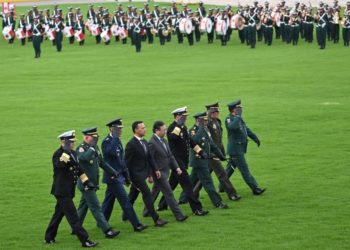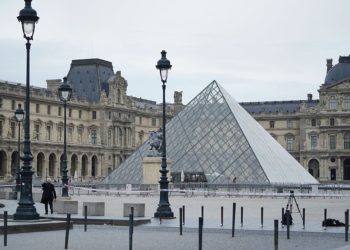This article is part of the Fine Arts & Exhibits special section on how creativity can inspire in challenging times.
In a digital time-lapse by the London-based artist studio ScanLAB, a tall saguaro cactus in the Sonoran Desert slowly falls, its parched branches crumbling to the ground. Known to live to 150 years or more, the saguaro is a symbol of resilience, weathering the extremely hot, dry summers in the region by subsisting on water stored from the rainy periods.
Encompassing over 100,000 square miles across Arizona, California and northwestern Mexico, the Sonoran Desert is home to an abundance of well-adapted plants like the saguaro. With increasing temperatures and longer droughts, however, these steadfast species are struggling to survive.
“In recent years, the Sonoran Desert has been the driest and hottest we’ve seen, and it is expected to get worse,” said Raul Puente-Martinez, research botanist and curator of living collections at the Desert Botanical Garden in Phoenix. “We are having to rethink how to care for our plants as the climate changes. When I speak with other botanical gardens, I say that maybe you haven’t seen it yet in your communities, but it’s just a matter of time,” he said.
A few years ago, the garden invited ScanLAB to create a digital installation that explores how the changing climate was affecting plants, including the now fallen saguaro. ScanLAB is among a handful of artist-led groups using data to explore the climate crisis, giving visual forms to complex and daunting subjects, not to spark fear but rather to educate on the facts.
Using tools like three-dimensional scanners and collaborating with local photographers and scientists, ScanLAB created time-lapse artworks of sites across the garden and the Sonoran Desert — as well as of blooming cactuses scanned inside its studio in London — returning to some places for a full year. The team also featured sites like housing developments encroaching on the garden and straining waterways to highlight potential causes of the changes to the environment.
The resulting digital artworks debuting this fall in “Framerate: Desert Pulse” show the fragility of the local flora, as well as its resiliency and beauty, with plants growing and vibrant blooms opening and closing. “It gives you a sense of time outside your perception,” ScanLAB co-founder William Trossell said. “There’s a lovely dance that occurs. Cacti are breathing, moving and are responsive to the environment.”
While “Framerate” offers a glimpse of a future that is already occurring in some climates, other artists imagine a world past the point of survival. One such project, the Danish artist Jakob Kudsk Steensen’s “Boreal Dreams” (2025), debuted earlier this year in “Northern Lights” at the Fondation Beyeler near Basel, Switzerland. The digital installation, which exists via an interactive website, features simulations of the boreal forest at five temperatures starting with ambient (usually surrounding temperature) and increasing to nine degrees Celsius when the forest is “only a memory,” says the explanation on the screen. Created with data from the Marcell Experimental Forest — the Minnesota research center studying the effects of global warming — Steensen’s installation envisions desolate futures.
While visitors to the Beyeler could watch the forest cycle through climate zones on a screen outside the museum, users who engage with the project’s website have a more intimate interaction, navigating the landscape at each temperature and reading devastating details of how ecosystems deteriorate as the permafrost melts, water evaporates and species disappear. Inspiring a visceral awareness of the changing climate, the work includes a soundtrack designed to summon dreams of the boreal forest.
Near Boston, at the MIT Museum, the fiber artist Janet Echelman is taking a more abstract approach to visualizing climate change with her sculptural installation “Remembering the Future” (2025). On view in the museum’s lobby and visible to passers-by, the braided fiber work resembles a three-dimensional web hanging above the stairs. Guided by MIT’s Raffaele Ferrari, professor of oceanography and co-director of the institute’s Lorenz Center for climate research, Echelman used climate data from the last ice age to the present, as well as projected future environments, to create a geometric design.
“I am acutely aware of, and overwhelmed by, news about the climate,” Echelman said in an interview. “It feels like data is coming at me and I don’t have the tools to make meaning of it.”
To translate this feeling into a visual form, Echelman worked with Caitlin Mueller, MIT associate professor of building technology, whose lab developed a tool to model the netlike structure of Echelman’s knotted and intertwined fibers as complex as the data itself.
To accompany the sculpture, Mueller created an interactive tool accessible through a kiosk and website that brought audiences behind the scenes in how she and Echelman engineered the design. “It’s a high-fidelity digital twin of the sculpture generated through our computational simulation that you can orbit and pan through to get perspectives that you can’t see physically in the space,” said Mueller.
For Echelman, giving viewers agency to interact with the design is an important part of the piece. “You’re not just looking at the work, you’re being brought in, because you are a designer, too,” she said. “We are all designing the future through our actions.”
At the Whitney Museum, “The River is a Circle” (2025), an animation by Marina Zurkow and James Schmitz on the fifth-floor terrace, takes this message further, inviting viewers to see the past, present and future as coexisting.
The software-driven artwork illustrates the Hudson River split horizontally to show activity above and below the water, depicting tide levels, sunrise and sunset — calculated by the work itself through existing data — as well as marine traffic and weather obtained from live, external applications.
The visuals include Atlantic sturgeon and objects like doughnuts to represent police boats. Others resemble islands carrying iconography of New York’s history from Lenape settlements to today, all shown together without concern for chronology.
To these, the artists added potential future scenarios: “One terrible one, if everything is business as usual and one not so bad future,” Zurkow said. In the terrible future, islands with gated and surveilled communities float along the water. In the less dreadful scenario, they carry objects like solar panels emblematic of renewable energy.
“There was never going to be a positive future in the work, that’s no longer possible,” Zurkow explained. “But things don’t have to be terrible if we don’t let them. We are part of climate systems, not passive subjects,” she said.
The post Art and Data Team Up Against Climate Change appeared first on New York Times.




